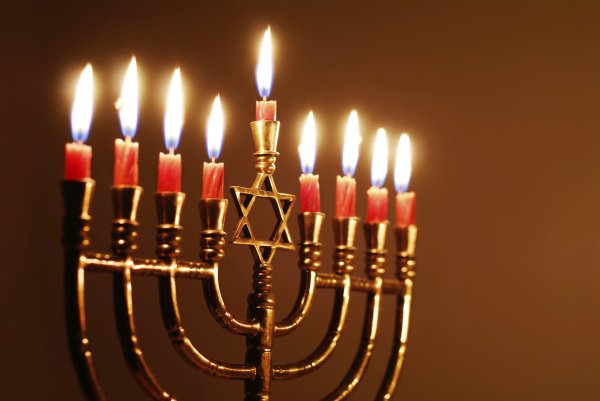There was once a public debate between a rabbi and an astrophysicist regarding the nature of our universe. The astrophysicist, representing the atheist perspective, confidently approached the podium and began addressing the audience: “I don’t know much about Judaism, but I believe I can sum it up in a few words: Do unto others as you would have them do unto you.” With that, he went on to detail how physicists could now adequately explain the nature of our universe, without the need for religion. When he finished his speech, it was the rabbi’s turn to address the audience and represent the religious approach. With a sparkle in his eye, he turned to the crowd, and said: “I don’t know much about astrophysics, but I believe I can sum it up in a few words: twinkle twinkle little star how I wonder what you are.” With that, he went on to deliver the rest of his speech.
The Age-Old Debate
Spiritual debate has been a recurring phenomenon since the beginning of time. Chanukah is when we tap into the spiritual debate between the Jews and the Greeks, as the Greeks specifically attempted to destroy our spiritual way of life. They aimed to cut off our connection with Hashem and replace it with the worship of the natural, physical world. Yavan means quicksand in Hebrew- the Greeks sought to “drown” us in their secular culture, replacing spirituality with atheism and hedonism. The midrash says that the Greeks attempted to darken our eyes- “hichshichu es eineichem” (Bireishit Rabbah 2:4). Darkness represents a lack of clarity, the inability to perceive true form. Physical darkness prevents physical clarity, spiritual darkness prevents spiritual clarity. This was the Greek attack on the Jewish people: a distortion of truth, a darkening of knowledge and perception. For this reason, the Jewish People went to war against the mighty Greek army, and to this day we carry on that fight against Greek culture, a culture that we view as damaging and antithetical to Judaism.
Greek Culture
However, if we take a deeper look into Jewish literature, we find a striking different picture of the Greek nation and their culture. In parshas Noach, Noach blesses his two sons, Shem and Yefes, with a seemingly peculiar bracha: “Yaft Elokim l’Yefet, v’yishkon b’ohalei Shem” (Bireishis 9:27)- Hashem will grant beauty to Yefes, and he will dwell within the tents of Shem. Yefes is the precursor to the Greeks, and Shem to the Jews. This seems to paint the Greece in a positive light, as a beautiful nation fitting to dwell within the framework and boundaries of Judaism. In a similar vein, the Gemara (Megillah 9b) states that despite the general prohibition of translating the Torah into different languages, it is permissible to translate the Torah into Greek, because it is a beautiful language. According to both of these sources, it seems as though Greeks culture does not contradict Judaism, but is meant in some way to complement it, harmonizing with Jewish ideology. How can we understand this contradiction? In order to explain it, we must first develop a deep spiritual principle.
The Spiritual-Physical Relationship
How do we understand and perceive Hashem? Is Hashem within time and space, limited to this world alone, as Pantheists believe? Or is Hashem completely transcendent, beyond time, space, and this physical world, as many of the ancient philosophers believed?
The Jewish approach, as explained by the Rambam, Maharal, Ramchal, and others, is a beautifully nuanced blend of these two approaches. Hashem is transcendent, completely beyond our physical world of time and space, and yet, He is also immanent, within our physical world. This principle applies to all spirituality; we believe that the spiritual and transcendent is deeply connected to the limited and physical world. In other words, our physical world is a projection and emanation of a deeper, spiritual reality. This is the meaning behind the famous midrash, “Istaklah bi’oraisa, u’bara alma” (Bireishit Rabbah 1:1), Hashem looked into the Torah and created the world. This means that the physical world is an emanation and expression of the Torah, the spiritual root of existence. To give an analogy, imagine a projector: the image you see on the screen is emanating from the projector. The projector and film are the source, the image on the screen is the expression. Similarly, each and every one of us was once a zygote, half and male and half a female genetic code. From that single cell a fully developed and expressed human being ultimately manifested. The same is true regarding the physical world, it stems from a spiritual root, a transcendent dimension.
Thus, we are able to understand and experience the spiritual through the physical, as the two are intrinsically connected. If you’re wondering how to understand this concept, consider the way other human beings experience, relate to, and understand you. All they have ever seen is your physical body. They’ve never seen your thoughts, your consciousness, or your emotions. The only way they can understand you is by relating to how you express yourself and your internal world through your physical body. Through your words, actions, facial expressions, and body language, other people experience what’s going on inside of your body, inside of your head, inside of you.
The same is true regarding our experience Hashem and the spiritual. We can’t see spirituality, only physicality. We must therefore use the physical to connect back to the spiritual root.
The Battle of the Chanukah
The Greeks sought to uproot this Jewish perspective, to detach the physical world from its higher root. They claimed that human beings have no connection to anything higher than the physical world itself, and that it’s therefore impossible to connect to Hashem. As the Ramban explains (Va’Yikrah 16:8), the Greeks believed only that which the human intellect could grasp. Anything that requires spiritual sensitivity, that goes beyond rational proofs alone, was dismissed as false. Even the Greeks gods were glorified humans- as anything that transcended the physical, human world was dismissed. In essence, the Greeks served themselves.
The Jewish Perspective
The Jewish approach is much more nuanced. We embrace human intellect and reason, but are aware of a realm that transcends it. We recognize the wisdom of science, medicine, psychology, mathematics, and other forms of madda, but also recognize a higher form of wisdom, the Torah. As the Vilna Gaon explains, where logic and human intellect ends, Jewish wisdom begins. The logic behind this principle is based on the aforementioned idea: the physical world is an expression of the spiritual world. Just as the physical world stems from a higher-spiritual realm, physical wisdom is an expression of a higher form of wisdom, the Torah. While the wisdom of madda is true, it stems from a higher truth, the Torah. Torah U’madda means that Torah is the absolute foundation and root, and madda is its physical expression.
Post-Rational Truth
Although we may naturally feel a need to defend the supremacy of logic alone, it is clear that the post-rational plays a fundamental role in our lives. The fact that you exist, that you possess free will, that there are standards of absolute morality, and even the existence of love and beauty do not require rational explanation. You don’t need to prove to yourself that these are real, you experience them. Philosophers have yet to prove that these phenomena exist, nor does modern science prove the existence of free will. These principles lie in a plane beyond reason and logic. Anyone who’s been in love knows that the feeling cannot be rationally explained; it’s something you experience so fully, but can’t put into finite words. You can’t break it down into finite components and rationally explain “why” you’re in love.
It’s fascinating to see how the modern scientific world is beginning to realize the profound nature of post-rational truth as well. Until the early 20th century, Newtonian physics was the universally accepted theory of physics; it was a logical and rational way of understanding the physical world. However, in the early 20th century, with the discovery of quantum mechanics, everything changed. Suddenly, logic and reason broke down, and reality could no longer be explained with these intellectual tools alone. A post-rational science began to unfold. Now, scientists are attempting to bridge the gap, and synthesize the rational with the post-rational
Torah as the Source of the Post-Rational
Torah represents post-rational experience. As the commentaries explain, when we received the Torah on Har Sinai, we all became prophets, experiencing a post-rational and transcendent connection with Hashem. Nevuah is not a rational and logical exercise; it transcends the human intellect. The Greeks did not believe in anything that transcends the human intellect, and thus rejected the Torah, prophecy, and miracles. R’ Tzaddok of Lublin goes as far as to say that even if Aristotle had been at Matan Torah, the very next day he would have given 100 reasons why it was logically impossible, and must therefore have been an illusion.
The Ideal Relationship
The ideal is for the physical wisdom of the Greeks and Yefes to be within the tent of Shem. For science and madda to be in harmony with Torah. The problem occurred only once the Greeks denied the existence of anything beyond their independent intellectual wisdom. This was the battle of Chanukah. The Greeks tried to destroy the Torah, which contradicted their ideology, and the Jews were forced to fight for their beliefs, to defend their spiritual connection with Hashem and the transcendent wisdom of Torah.
Rav Hutner explains that Chanukah is the chag of Torah Sheba’al Peh, the oral Torah. Chanukah is the one holiday with no source in Torah Shebiksav. Unlike Purim, it does not even have a Megillah; it is completely of rabbinic origin. Furthermore, it doesn’t even have a Mishnah; the only canonized source for Chanukah is a few gemaras which mention Chanukah in an almost coincidental manner. Why is this?
Chanukah represents the battle against the Greeks. The Greeks claimed that the only source of truth is the human intellect; nothing transcends human logic. The Jews not only showed that there is a transcendent source of truth, but took it one step further. When done appropriately, with humility and proper recognition of the Torah’s transcendent root, the limited human being can actually use his human intellect to participate in the creation of Torah. This is the unbelievable nature of Torah Sheba’al Peh: human beings are given the ability to participate and even create novel Torah ideas and insights. The greatest victory over the Greeks wasn’t to simply prove that transcendent Torah exists; it was to reveal that even the human intellect can connect to Torah, even limited human beings can connect to the infinite.
Our Place of Connection The Greeks tried to spiritually destroy our Beis Ha’mikdash, the point of connection to the transcendent, where Hashem most intimately connects to this physical world. After our victory on Chanukah, we reignited the flame of that spiritual building, and every year since, we must reignite that same flame within our own homes; we must inaugurate our own personal Beis Ha’mikdash every year.
Every day, we get to choose whether we’ll get stuck further in secular and Greek culture, or, if we’ll build our connection to the infinite, the transcendent, and carry the message of Chanukah deep within our hearts. Our life is like building a personal Beis Ha’mikdash, building an ever-deeper and ever-closer relationship with Hashem. It’s the result of every brick we lay down; every day is like another brick, another opportunity to add to our eternal home, our eternal self, our eternal existence.







